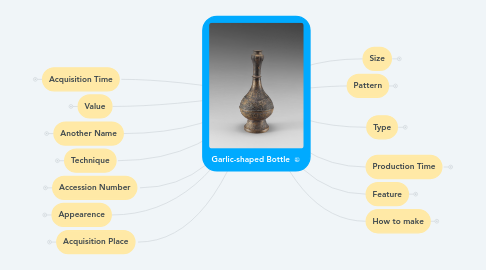
1. Acquisition Time
1.1. This pottery was discovered in 1980.
2. Value
2.1. t was produced from Jin Dynasty, China, and imitation production began in Song Dynasty, leading to Yuan Dynasty.
2.1.1. Jin Dynasty
2.1.1.1. The Qin Dynasty is a dynasty consisting of Seojin, a unified dynasty, and Dongjin, one of the southern dynasties of the Northern and Southern Dynasties. The fall of the Qin Dynasty is considered one of the events that end the Spring and Autumn Period.
2.1.2. Song Dynasty
2.1.2.1. The Song Dynasty was founded in 960 by Cho Kwang-yoon in Gaebong (Kai Feng). Song Eun-yo, Seoha, and the Geum Dynasty in the north had constant conflicts over supremacy, and eventually collapsed by the Yuan Dynasty established by the Mongolians.
2.1.3. Yuan Dynasty
2.1.3.1. The Yuan Dynasty is a Mongolian kingdom that dominated almost all of East Asia, centering on mainland China, between the mid-13th century and the mid-14th century.
3. Another Name
3.1. Sanhyeonggubyeong
3.1.1. Sanhyeonggubyeong, found on the Sinan shipwreck, which means a garlic-shaped bottle.
4. Technique
4.1. Unknown
5. Accession Number
5.1. Sinan 6642
6. Appearence
6.1. The entrance of the bottle consists of six-sided garlic, gup is made by two-stage, and the lower part is a triangular frame.
6.1.1. Frame
6.1.1.1. The frame of an object such as a building, chair, or window is the arrangement of wooden, metal, or plastic bars between which other material is fitted, and which give the object its strength and shape
6.1.2. Gup
6.1.2.1. Gup is connected with pottery bottom, and is made for supporting pottery.
6.1.3. Yukjjokmaneul
6.1.3.1. Yukjjokmaneul means 6 pieces of garlic.
6.2. On the inside of the gup, six letters of "Jason Yeongbo Yongji" are engraved.
6.2.1. Jason Yeongbo Yongji
6.2.1.1. Jason Yeongbo Yongji means to keep this for generations.
7. Acquisition Place
7.1. This relic was found in Sinan.
7.1.1. Different artifacts were obtained from the same place.
7.1.1.1. Crane-pattern pillow
7.1.1.2. Black dot-patterned jar
7.1.1.3. Water buffalo-shaped yeonjeok
7.1.1.4. Lion-shaped incense burner
7.1.1.5. Dragon-pattern prunus vase
7.1.1.6. Kettle
7.1.1.7. Celadon large vase with applique chrysanthemum design
7.1.1.8. Dark-glazed wan
7.2. Sinan shipwreck
7.2.1. Sinan shipwreck became known in 1975 when a fisherman caught six pottery in a net while fishing. The fisherman reported the pottery to the Sinan-gun office in January of the following year, and excavation began in October of that year. In the sea, a large number of artifacts for foreign trade, including celadon made during the Yuan Dynasty, were excavated.
8. Size
8.1. H. 24cm
9. Pattern
9.1. Cicadas pattern(bottom, gup)
9.2. monster pattern(upper part of the body)
9.3. flowers and ungi patterns (bottom)
9.4. hexagonal patterns(bottom)
9.4.1. hexagonal patterns also called Gwigapmun. It means a pattern of the turtle's back and has the meaning of longevity.
9.5. lightning pattern(upper part of the body, gup)
10. Type
10.1. Metal pottery
11. Production Time
11.1. Yuan Dynasty
11.1.1. The Yuan Dynasty is a Mongolian kingdom that dominated almost all of East Asia, centering on mainland China, between the mid-13th century and the mid-14th century.
11.1.1.1. Other relics made during the Yuan Dynasty
11.1.1.1.1. Black dot-patterned jar
11.1.1.1.2. Water buffalo-shaped yeonjeok
11.1.1.1.3. Lotus&fish-patterned wan
11.1.1.1.4. Dragon-pattern prunus vase
11.1.1.1.5. Kettle
11.1.1.1.6. Celadon large vase with applique chrysanthemum design
